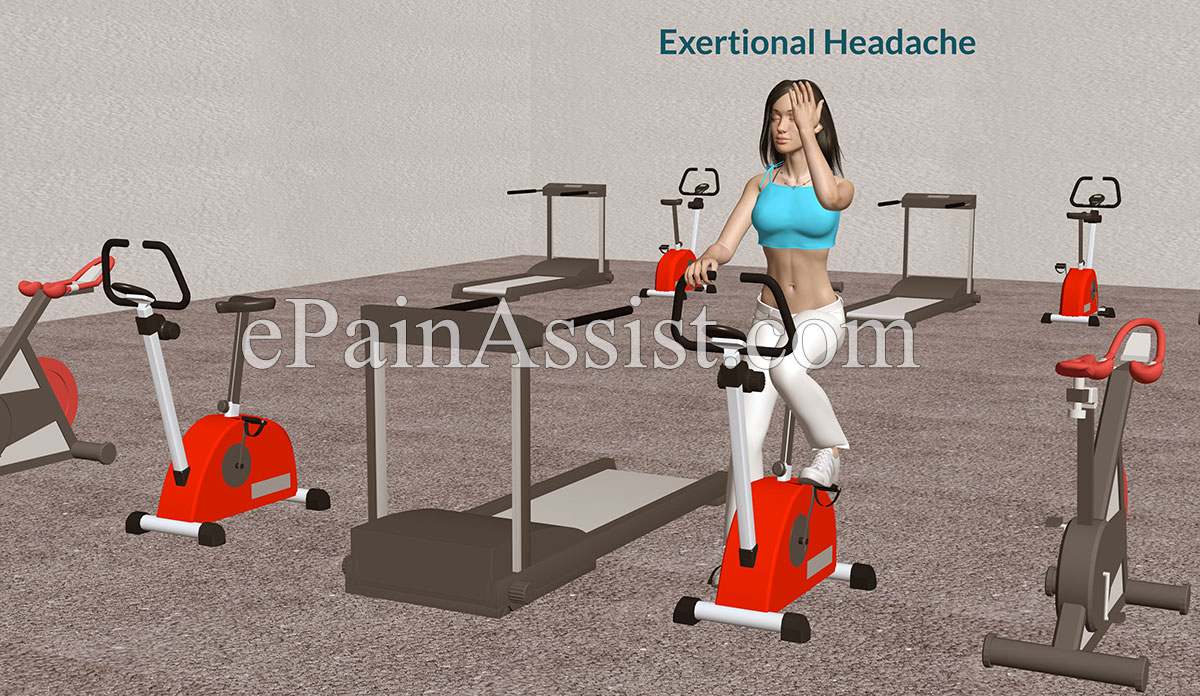Benign exertional headache, also commonly known as exercise headaches, is a type of headache, which an individual suffers from while doing a vigorous activity or after that particular activity. It could be any type of strenuous physical activity such as exercising, running, playing tennis, jogging, swimming, and weightlifting etc. Adolescents and young adults are more prone to these types of headaches. In case of predictable headaches, i.e. headaches occurring at a specific time or during certain activities benefit from taking medications beforehand.

Types of Exertional Headaches or Exercise Headaches
Exertional Headaches or Exercise Headaches are Divided Into Two Types
- Primary Exertional Headaches: These are often harmless and do not stem from any underlying medical problem. They are easily prevented and relieved by taking medication.
- Secondary Exertional Headaches: These headaches occur after any type of exertion because of other underlying medical problem in the brain, such as tumor or a bleed in the brain. Coronary artery disease could also trigger these headaches. Secondary exercise headaches should not be ignored and they need immediate medical attention.
Causes of Exertional Headaches or Exercise Headaches
- Primary Exertional Headaches: The exact cause of this type of headaches is not known. According to experts, they occur as a result of dilatation of the blood vessels in the brain due to strenuous activities.
- Secondary Exertional Headaches: The cause for these headaches is serious underlying problems like:
- Subarachnoid hemorrhage, which is bleeding occurring in the region between the brain and the arachnoid membrane.
- Any blood vessel abnormalities in the brain.
- Tumors (cancerous/noncancerous).
- Hindrance in the flow of cerebrospinal fluid.
- Decreased blood supply to the heart.
- Infection of sinuses.
Primary exercise headaches resolve within a few hours; whereas secondary exercise headaches may last for more than a day and are often serious in nature.
Risk Factors of Exertional Headaches or Exercise Headaches
- Exercising or engaging in vigorous physical activities in hot weather.
- Exercising or engaging in vigorous physical activities at a high altitude.
- Family history or previous history of migraine.
- Adolescents and young adults are more prone to having primary exercise headaches.
Symptoms of Exertional Headaches or Exercise Headaches
Primary Exertional Headaches or Exercise Headaches Have the Following Symptoms
- Throbbing in nature.
- Patient experiences them while doing strenuous activity or after that activity.
- Is usually bilateral in nature.
Secondary Exertional Headaches or Exercise Headaches Have the Following Symptoms
Throbbing in nature and occur doing any strenuous activity of after that activity.
- Is usually bilateral in nature.
- Patient has vomiting.
- May lose consciousness
- Patient experiences double vision or other visual disturbances.
- Neck stiffness.
Investigations for Exertional Headaches or Exercise Headaches
- CT Scan: This test produces cross-sectional images of the brain and is useful in finding out whether there has been any recent bleeding internally or externally in the brain.
- MRI (Magnetic Resonance Imaging): Magnetic field and radio waves are used to generate cross-sectional images of structures present inside the brain.
- MRA (Magnetic Resonance Angiography) and CT Angiography: These tests are done to assess the blood vessels in the brain.
- Lumbar Puncture or Spinal Tap is done if the onset of the headache is sudden in nature and if the rest of the brain imaging tests is normal.
Treatment for Exertional Headaches or Exercise Headaches
For secondary exertional headaches, treating the underlying cause will resolve the headaches.
Medications help in preventing and relieving primary exertional headaches. If the headaches are predictable, then medicines can be taken an hour or so before a scheduled physical activity such as jogging, trekking etc. If the headaches are unpredictable, then preventive medicine may have to be taken on a daily basis. The following medicines help in preventing these headaches:
- Anti-inflammatory drugs such as indomethacin are often prescribed for exertional headaches, which have no underlying cause.
- Blood pressure medications such as propranolol (Inderal) are given to prevent the exercise headaches.
Prevention of Exertional Headaches or Exercise Headaches
- Avoid exercising or engaging in any strenuous physical activity in hot and humid weathers.
- Doing warm-ups before any strenuous exercise also helps in preventing exercise headaches.
- Drink lots of water to prevent dehydration and headaches.
- Avoid high altitudes if you are prone to headaches at these places.
- Take medications for headaches if they are predictable.
- Following a healthy diet and lifestyle always helps with any health problem.
